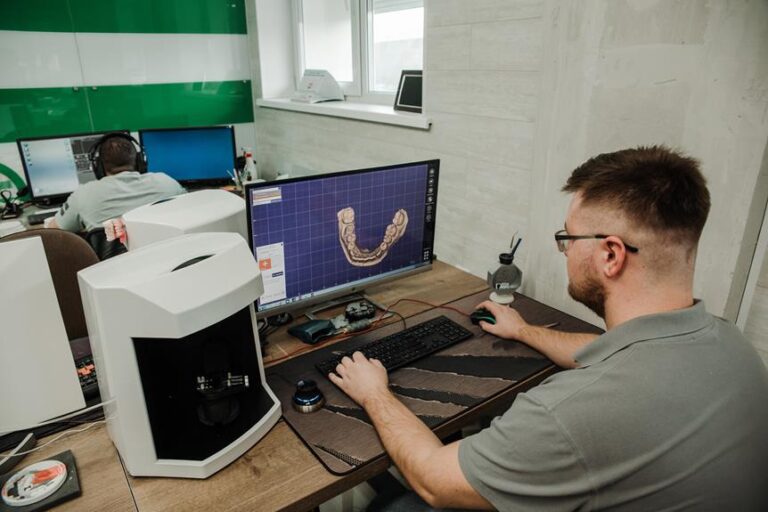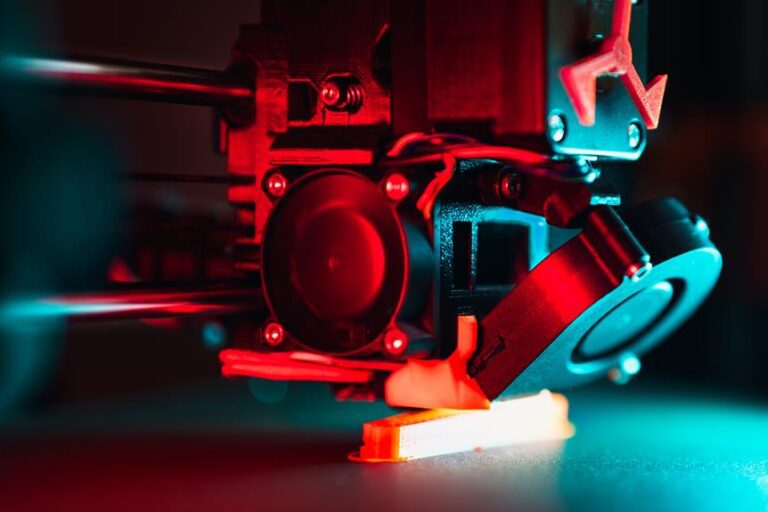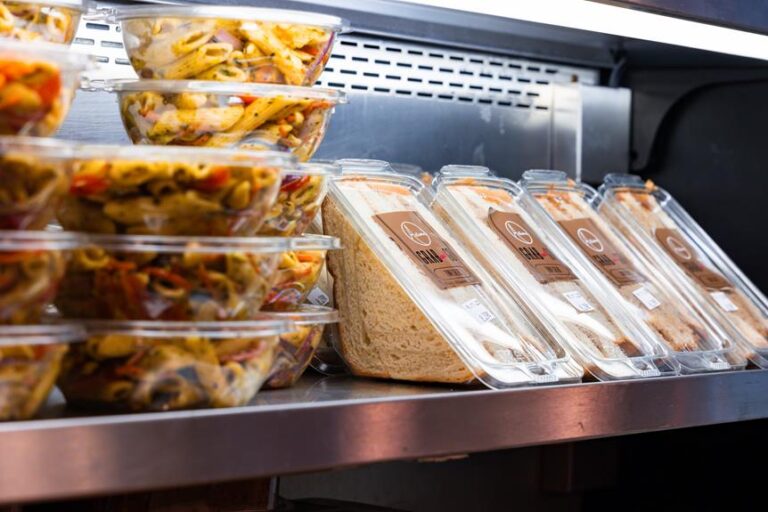3D Printed Food and Culinary Innovations: Blending Technology and Gastronomy
Step into a world where culinary boundaries are pushed, and gastronomy meets cutting-edge technology. In this article, we delve into the realm of 3D printed food and culinary innovations, where pixels transform into palatable masterpieces.
From the evolution of 3D printed food to the exploration of flavor and texture, we uncover the transformative impact of this revolutionary technology.
Join us as we unravel the future of food and witness the blending of technology and gastronomy, liberating the possibilities within the culinary landscape.
Key Takeaways
- 3D printed food revolutionizes the culinary industry by allowing for precision and control in design, customization for dietary needs, and creation of intricate and complex dishes.
- Creative plating and presentation options are enhanced through 3D printing, enabling chefs to create visually stunning food presentations with unique designs, patterns, and shapes.
- Flavor and texture customization is achieved through 3D printing by infusing flavors, manipulating textures, and layering different flavors to create multi-dimensional taste experiences.
- Personalization and customization of dishes are made possible with 3D printing, catering to individual preferences, dietary restrictions, and nutritional needs, while also allowing for custom portion sizes and ingredients.
The Evolution of 3D Printed Food
The evolution of 3D printed food has revolutionized the culinary industry and sparked a new era of gastronomic possibilities. Culinary 3D printing, also known as gastronomy innovation, is the application of additive manufacturing technology to create food in three dimensions. This cutting-edge technology allows chefs and food enthusiasts to push the boundaries of creativity and presentation in the kitchen.
3D printed food is created by depositing layer upon layer of edible material, such as dough, chocolate, or even meat, to build intricate and unique structures. This process offers unparalleled precision and control, enabling chefs to design and construct complex shapes and textures that were previously unattainable.
The advantages of 3D printed food extend beyond aesthetics. This innovative technique also allows for customization and personalization, catering to specific dietary needs and preferences. People with dietary restrictions or allergies can now enjoy meals that are tailored to their requirements, without compromising on taste or presentation.
Furthermore, 3D printed food opens up possibilities for sustainable and efficient food production. By optimizing ingredient usage and reducing waste, this technology has the potential to address food scarcity and minimize the environmental impact of traditional food production methods.
Cutting-Edge Techniques in Culinary Printing
Cutting-edge techniques in culinary printing have brought about exciting advancements in the realm of flavors and textures.
Through the use of 3D printing technology, chefs are now able to create intricate and complex dishes that tantalize the taste buds in entirely new ways.
Moreover, culinary printing allows for innovative plating options, enabling chefs to present their creations in visually stunning and creative ways, enhancing the overall dining experience.
Flavors and Textures
With advancements in culinary printing technology, innovative techniques have emerged to enhance flavors and textures in food. The combination of 3D printing and food additive manufacturing has opened up new possibilities for creating unique culinary experiences.
Here are some cutting-edge techniques that are pushing the boundaries of flavor and texture customization:
- Flavor Infusion: 3D printers can now infuse food with different flavors during the printing process, allowing for a more intense and diverse taste experience.
- Textural Manipulation: By adjusting the printing parameters, chefs can create foods with varying textures, from smooth and creamy to crispy and crunchy.
These techniques not only provide a new level of creativity for chefs but also allow for personalized dining experiences. With 3D printed food, the possibilities are endless, and the culinary world is just scratching the surface of what can be achieved.
Creative Plating Options
By exploring new techniques in culinary printing, chefs can create unique and visually stunning plating options that elevate the dining experience. Culinary printing allows for intricate and precise designs to be created, enabling chefs to showcase their creativity and artistry on the plate.
With the ability to print edible materials in various textures and colors, chefs can design plates that are not only visually appealing but also enhance the flavors and textures of the dish. From delicate lace-like patterns to intricate 3D structures, culinary printing offers endless possibilities for creating visually captivating dishes.
Chefs can experiment with different printing techniques such as layering, molding, and even printing directly onto the plate itself. These cutting-edge techniques in culinary printing provide chefs with the freedom to push the boundaries of traditional plating and create truly innovative and extraordinary dining experiences.
Exploring the Intersection of Technology and Taste
As technology continues to advance, the future of food tech holds immense potential in revolutionizing the culinary landscape.
Through the use of 3D printing and other cutting-edge techniques, culinary creativity is unleashed, allowing chefs to push the boundaries of flavor, texture, and presentation.
This intersection of technology and taste has the power to transform the dining experience, offering new and exciting possibilities for both chefs and diners alike.
Future of Food Tech
Significantly, the future of food tech holds immense potential in revolutionizing the culinary landscape by seamlessly merging technological advancements with the intricate world of taste. This convergence of technology and taste opens up a world of possibilities for food innovation and exploration.
Here are some key points to consider:
- Personalized nutrition: With the help of advanced data analysis and smart devices, individuals can have access to personalized nutrition plans that cater to their specific dietary needs and preferences.
- Sustainable practices: Technology can play a vital role in promoting sustainable practices in food production, such as vertical farming, hydroponics, and precision agriculture.
- Reduced food waste: By leveraging data analytics and IoT devices, we can optimize food storage, transportation, and distribution, minimizing waste and ensuring food reaches consumers in its freshest state.
The future of food tech holds great promise in enhancing our culinary experiences while promoting sustainable and personalized approaches to nutrition.
Culinary Creativity Unleashed
Harnessing the power of technology, culinary creativity is unleashed, allowing chefs and food enthusiasts to explore the intersection of technology and taste in unprecedented ways.
The fusion of technology and gastronomy has opened up a realm of possibilities, liberating chefs from traditional cooking methods and enabling them to push the boundaries of culinary artistry.
With the advent of 3D printing, chefs can now create intricate and visually stunning dishes that were once unimaginable. By utilizing specialized printers and edible materials, they can design intricate food structures, personalized shapes, and even replicate complex textures. This technological breakthrough not only enhances the visual appeal of the dishes but also allows for precise control over flavors and ingredients.
Furthermore, advancements in virtual reality and augmented reality have revolutionized the dining experience, enabling diners to interact with their food in immersive and interactive ways.
This convergence of technology and taste has truly liberated culinary creativity, opening up new avenues for innovation and providing a platform for chefs to showcase their artistic vision.
Impact on Dining Experience
By seamlessly integrating cutting-edge technology and culinary expertise, the dining experience is elevated to new heights, offering a harmonious blend of innovative flavors and immersive sensory encounters.
The impact of 3D printed food on the dining experience is profound, revolutionizing the way we perceive and consume food. Here are a few ways in which this technology is transforming the dining landscape:
- Personalization: 3D printing allows chefs to create customized dishes tailored to individual preferences, dietary restrictions, and nutritional needs, providing a truly personalized dining experience.
- Aesthetic Appeal: Intricate and artistic designs can be effortlessly created with 3D printers, enhancing the visual appeal of dishes and captivating diners' attention.
With these advancements, 3D printing is revolutionizing the culinary landscape, offering endless possibilities for creativity and innovation.
As we delve deeper into this topic, we will explore how this technology is reshaping the way we prepare and present food, creating a truly immersive and extraordinary dining experience.
Revolutionizing the Culinary Landscape With 3D Printing
With its ability to transform ingredients into intricate shapes and designs, 3D printing is revolutionizing the culinary landscape. This technology is liberating chefs and food enthusiasts from the constraints of traditional cooking methods, enabling them to create unique and visually stunning dishes.
By utilizing computer-aided design (CAD) software, chefs can design and print customized molds, allowing them to experiment with new forms and textures. These molds can be used to create intricate chocolate sculptures, delicate sugar decorations, or even personalized pasta shapes. 3D printers can also extrude food materials layer by layer, creating complex structures that were previously impossible to achieve by hand.
This opens up a world of possibilities for creating innovative and artistic presentations. Additionally, 3D printing enables chefs to cater to specific dietary needs and preferences. By precisely controlling the ingredients and their placement, chefs can create personalized meals that meet the nutritional requirements of individuals with allergies or dietary restrictions.
Furthermore, 3D printing can reduce food waste by utilizing every bit of an ingredient and minimizing trimming and scraps. Overall, 3D printing is transforming the culinary landscape by offering new avenues for creativity, personalization, and sustainability.
From Pixels to Palate: The Artistry of 3D Printed Cuisine
The artistry of 3D printed cuisine comes to life as pixels on a screen are transformed into delectable dishes that delight the palate. This innovative culinary technique combines the precision of technology with the creativity of gastronomy, resulting in a unique dining experience that pushes the boundaries of traditional cooking methods.
Here are two fascinating aspects of the artistry of 3D printed cuisine:
- Unlimited Design Possibilities: With 3D printing, chefs can create intricate and complex designs that were once unimaginable. From geometric shapes to intricate patterns, the possibilities are endless. This technology allows for precise layering and shaping of ingredients, resulting in visually stunning dishes that are as pleasing to the eye as they are to the taste buds.
- Customization and Personalization: 3D printed cuisine allows chefs to tailor dishes to individual preferences and dietary restrictions. By adjusting the ingredients, textures, and flavors, chefs can create personalized meals that cater to specific dietary needs or preferences. This level of customization opens up new avenues for culinary exploration and ensures that each diner's experience is unique and memorable.
As the artistry of 3D printed cuisine continues to evolve, chefs are discovering new ways to push the boundaries of gastronomy, creating dishes that are not only visually captivating but also delicious. This fusion of technology and gastronomy promises to revolutionize the culinary landscape, offering diners a truly liberating dining experience.
Innovations in Flavor and Texture With 3D Printed Ingredients
Innovative chefs are exploring new ways to enhance flavor and texture through the use of 3D printed ingredients. With the advent of 3D printing technology, culinary experts are able to reimagine the possibilities of taste and mouthfeel in their creations. By precisely controlling the composition and structure of food at a microscopic level, chefs can manipulate the sensory experience of their dishes.
One area where 3D printed ingredients have made significant advancements is in the realm of flavor. By combining different ingredients in precise ratios and geometries, chefs can create complex and innovative flavor profiles that were previously impossible to achieve. For example, the ability to print layers of different flavors allows for the creation of multi-dimensional taste experiences. This opens up a whole new world of possibilities for creating unique and memorable dining experiences.
Texture is another aspect that has been revolutionized by 3D printed ingredients. By controlling the density, porosity, and arrangement of food particles, chefs can create textures that range from creamy and smooth to crispy and crunchy. This level of control allows for the creation of dishes with contrasting textures, adding an extra dimension to the dining experience.
As 3D printing technology continues to evolve, the future of food and gastronomy looks incredibly promising. Chefs will have even more tools at their disposal to push the boundaries of creativity and innovation. The integration of 3D printing into the culinary world will undoubtedly transform the way we perceive and consume food.
The Future of Food: How 3D Printing Is Transforming Gastronomy
3D printing technology is revolutionizing the gastronomy industry by transforming the future of food. This groundbreaking technology is opening up new possibilities and pushing the boundaries of what we thought was possible in the culinary world.
Here are some ways in which 3D printing is transforming gastronomy:
- Customized Food: With 3D printing, chefs can create personalized dishes tailored to an individual's specific dietary needs or preferences. This allows for a new level of customization and ensures that everyone can enjoy a meal that suits their tastes and requirements.
- Creative Presentation: 3D printing enables chefs to create intricate and visually stunning food presentations that were previously unimaginable. From intricate sugar sculptures to unique shapes and designs, 3D printing allows chefs to unleash their creativity and take food presentation to a whole new level.
- Enhanced Texture: By using 3D printing, chefs can create foods with unique textures and consistencies. This opens up a world of possibilities for creating innovative dishes that combine different textures and elevate the dining experience.
- Sustainable Solutions: 3D printing can also contribute to a more sustainable future by reducing food waste. With precise ingredient measurements and the ability to create custom portion sizes, 3D printing allows for more efficient use of ingredients, minimizing waste and promoting sustainability.
- Culinary Innovation: 3D printing technology is constantly evolving, and its potential applications in gastronomy are still being explored. As the technology advances, we can expect to see even more innovative uses of 3D printing in the culinary world, from personalized nutrition solutions to new ways of experiencing food.
Frequently Asked Questions
How Does 3D Printing Technology Work in the Context of Food?
3D printing technology in the context of food involves the use of specialized printers that create edible objects by layering ingredients. This innovative process allows for the customization of food products, precise portion control, and the exploration of new textures and shapes.
What Are Some of the Challenges Faced in 3D Printing Food?
Some of the challenges faced in 3D printing food include ensuring food safety and quality, developing suitable materials for printing, maintaining the desired texture and taste, and optimizing the printing process for efficiency and accuracy.
Are There Any Health Concerns Associated With Consuming 3D Printed Food?
Health concerns associated with consuming 3D printed food include potential contamination, lack of nutritional value, and the safety of printing materials. Proper regulation, testing, and adherence to food safety standards are crucial in mitigating these risks.
How Does the Taste of 3D Printed Food Compare to Traditionally Prepared Dishes?
The taste of 3D printed food, when compared to traditionally prepared dishes, is a subject of ongoing research. While advancements in technology have enabled the replication of flavors, further studies are required to fully understand and optimize the taste experience.
What Are Some Potential Applications of 3D Printed Food Beyond the Culinary Industry?
Potential applications of 3D printed food extend beyond the culinary industry. With its ability to customize nutrition, texture, and appearance, it can be utilized in healthcare, space exploration, disaster relief, and personalized nutrition sectors, revolutionizing the way we consume food.
Conclusion
In conclusion, 3D printing has revolutionized the culinary landscape, blending technology and gastronomy in unprecedented ways. With cutting-edge techniques and innovative ingredients, chefs are able to create visually stunning and unique dishes that push the boundaries of flavor and texture.
The artistry and precision of 3D printed cuisine have transformed the way we perceive food, offering a glimpse into the future of gastronomy. This remarkable technology has truly transformed the way we experience and appreciate the culinary world.









